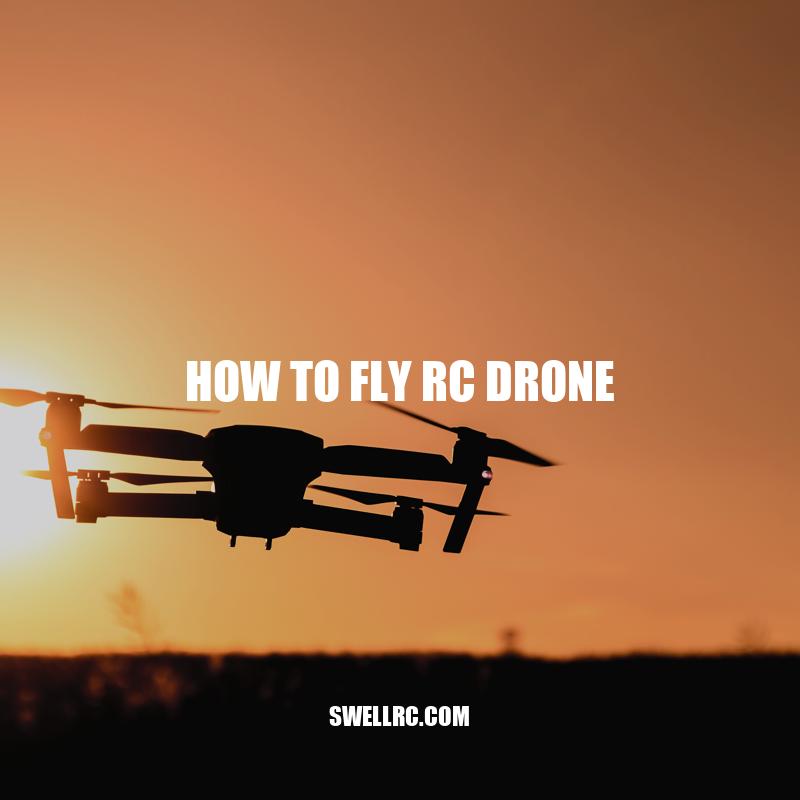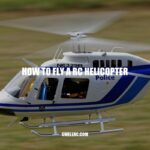How to Fly an RC Drone: A Beginner’s Guide
RC drones have become increasingly popular among hobbyists and professionals for various reasons. Whether you’re interested in aerial photography or just want to have fun flying a small aircraft, an RC drone can provide an exciting and rewarding experience. However, flying an RC drone is not as easy as it seems, and it requires a certain degree of knowledge and skills to be able to pilot it confidently. In this article, we will provide a comprehensive guide on how to fly an RC drone, covering everything from choosing the right drone to take-off, flying, and landing techniques, as well as troubleshooting tips and safety guidelines that you should follow. But first, let’s define what an RC drone is and why it has become so popular in recent years. An RC drone, also known as a remote-controlled drone, is a small aircraft that is controlled by a remote control device or a smartphone application. It consists of a frame, motor, battery, camera (optional), and several electronic components that enable it to fly. RC drones come in various shapes and sizes, and they can be used for different purposes such as recreational, commercial, or military applications.
Choosing the Right RC Drone
When it comes to choosing the right RC drone, there are several factors to consider, including:
- Price – You can find RC drones that range from less than $50 to several thousands of dollars, depending on the features and capabilities.
- Size – RC drones come in various sizes, from small indoor drones that can fit in your palm to larger outdoor drones that require a backpack to carry.
- Features – RC drones can have different features such as a camera, GPS, altitude hold, and obstacle avoidance.
- Specifications – It’s important to check the specifications of the drone such as flight time, range, speed, and weight capacity.
Some popular websites where you can shop for RC drones include Amazon, Best Buy, and DJI. These sites offer a wide range of drones from different brands and prices, and you can read reviews from other customers to help you make an informed decision. Additionally, some drone manufacturers offer online buying guides to help you choose the right drone for your needs.
Understanding the Controls and Features
Before taking off, it’s important to understand the controls and features of your RC drone. Some of the basic controls and functions include:
| Control/Function | Description |
|---|---|
| Throttle | Control the altitude and movement of the drone up or down by adjusting the throttle. |
| Yaw | Adjust the orientation of the drone to rotate around its central axis. |
| Pitch | Control the forward or backward movement of the drone. |
| Roll | Control the left or right movement of the drone. |
Other important features to understand include:
- Camera – The camera allows you to capture images or videos during flight, and some drones allow for live streaming or First Person View (FPV) flying.
- Altitude Hold – This feature helps the drone maintain a stable altitude while in flight, allowing for smoother video and image capture.
- GPS – Some drones have GPS that helps with navigation and returning home, and also helps with features such as follow-me and orbit modes.
Some popular websites for learning more about the controls and features of your RC drone include Drone Academy and UAV coach. These websites offer courses and tutorials on drone flying, including basic controls, advanced flying techniques, and tips for photography and videography using your drone.
How do you control a RC drone?
To control a RC drone, follow these steps:
- Charge the drone’s batteries and controller
- Turn on the controller and the drone
- Use the controller’s analog sticks to maneuver the drone
- Use the trim buttons to adjust the drone’s balance and stability
- Practice flying in wide open spaces to avoid collisions with obstacles.
For more in-depth understanding, you can refer to websites such as dronesglobe.com, which provides extensive guides and tutorials on flying drones. Additionally, you can check out popular drone models such as the DJI Mavic and the Parrot Bebop 2, which are known for their user-friendly controls.
Pre-Flight Preparation
Before taking off, it’s important to go through some pre-flight checks and preparations to ensure a safe and successful flight. Here are some important steps to take:
1. Check Battery Life
- Ensure the battery is fully charged before taking off.
- Check the battery voltage level from the controller or mobile device app if available.
- Bring extra batteries if you plan to fly for an extended period.
2. Check Propellers
- Make sure propellers are tightly secured and in proper orientation.
- Check for any damage or wear to the blades, and replace if necessary.
3. Calibration
- Calibrate the drone’s compass and gyroscope before takeoff.
- Ensure the drone is on a flat surface throughout the calibration process.
- Follow the instructions provided by the manufacturer for proper calibration.
4. Select a Suitable Flying Area
- Select a clear, open area free from obstacles and people.
- Check local regulations for flying areas and permissions if necessary.
- Choose a place without electromagnetic or radio interference that could affect the drone’s signal during flight.
5. Safety Gear and Equipment
- Wear safety gear such as gloves and goggles to protect from injury.
- Use a landing pad to protect the drone while taking off and landing.
- Bring a first-aid kit in case of an emergency.
Some popular websites for drone enthusiasts to prepare for their flights include DJI’s official website and the FAA’s drone flying guidelines. These websites offer information on regulations and permits, weather conditions, and best practices for aerial photography and videography.
Why are pre-flight checks important?
- Ensures the safety of the pilot, passengers and crew on board
- Helps to identify any potential issues or malfunctions with the aircraft before takeoff
- Allows for necessary adjustments and maintenance to be made prior to the flight
Pre-flight checks are essential for any aircraft to ensure a safe and successful flight. Neglecting to conduct proper pre-flight checks could result in disastrous consequences. Trusted aviation products like ForeFlight, FltPlan Go and Garmin Pilot are popular among pilots to assist with pre-flight checks and navigation.
Take-off, Flying, and Landing Techniques
Once all pre-flight checks are complete, it’s time to take off and enjoy the freedom of flying an RC drone. Here are some essential tips to help you take off, fly and land safely and effectively:
1. Take-off
- Make sure the drone is facing away from you.
- Arm the motors by following the instructions provided in the user manual.
- Slightly increase the throttle to lift the drone off the ground and adjust the altitude.
2. Basic Flying Techniques
- Familiarize yourself with the controls and practice basic maneuvers such as hovering and forward/backward movement.
- Use pitch, roll, and yaw control to move the drone around smoothly and effectively.
- Adjust the altitude by using throttle control.
3. Safe Landing
- Gradually decrease the throttle and descend the drone smoothly to the ground.
- Use throttle to adjust altitude and land softly.
- Deactivate the motors immediately once the drone lands on the ground.
To refine your techniques and become a pro-flyer, there are many resources available online or through classes and courses. Some popular websites offering tutorials, guides, and tips on flying RC drones include:
– RC Groups
– Flite Test
– UAV Coach
Furthermore, some RC drone manufacturers, such as DJI and Parrot, provide their own training services, including online video tutorials and customer support.
What are the 3 basics of flight?
The three basics of flight are lift, thrust, and drag. These principles are crucial for understanding how an aircraft can achieve and maintain flight. Aircraft wings use lift to counteract gravity and stay in the air. Thrust is the force that propels the aircraft forward or upward. Drag is the resistance the aircraft encounters as it moves through the air. To learn more about aviation and flight principles, check out websites such as NASA’s Aeronautics Research, Aircraft Owners and Pilots Association (AOPA), or products such as aviation books and simulators.
Troubleshooting and Tips for Beginners
Flying an RC drone can be a thrilling experience, but it’s not uncommon to encounter problems or challenges that can disrupt the flying experience. Here are some common issues that beginners are likely to face along with some tips for troubleshooting them:
1. Signal Loss
- Stay calm and don’t panic
- Check the connection between the drone and the controller.
- Check your drone is not too far away.
- Try repositioning your controller antennas
2. Motor Failure
- Avoid flying too close to any obstacles, including trees or buildings.
- Check the propellers and the motors for any visible damage.
- Check the battery levels
3. Flyaway
- Remove your hands from the controls
- Activate the fail-safe mode, which stops the drone and returns it to the takeoff point automatically.
- If all else fails, contact support from the manufacturer.
In addition to these troubleshooting tips, here are some general tips that can be useful for beginners to improve their flying skills and enjoy the experience to the fullest:
1. Practice in Low Wind Conditions
- Avoid flying in windy conditions until you’ve mastered the basic flight maneuvers.
- Practice in an open field until you feel confident enough to progress to more challenging environments.
2. Start with Basic Maneuvers
- Learn to fly forwards and backwards, side to side, and hover. Experiment with altitude control and turning.
- Gradually progress through more complex movements and techniques as you become more comfortable and confident.
3. Seek Professional Training
- Look for classes or workshops hosted by experienced RC drone pilots or manufacturers.
- Watch instructional videos and tutorials online.
There are many resources available online or through classes and courses to improve your flying and fix any issues you may have. You may also look for information on websites dedicated to RC drones such as:
– RC Geeks
– Drone U
– MyFirstDrone
Remember, safety is always paramount when flying an RC drone, so it’s important to follow safety guidelines and regulations at all times.
How do you have fun with a drone?
- Take aerial photos and videos of nature, landscapes, or your neighborhood.
- Participate in drone races and compete with other enthusiasts.
- Try out cool tricks and stunts, like flips and barrel rolls.
- Play games with your drone, such as drone hide-and-seek or capture the flag.
- Explore hard-to-reach areas, like the tops of buildings or over bodies of water.
Looking for a drone for your next adventure? Check out popular options like the DJI Mavic Air 2 or the Holy Stone HS100D on websites like Amazon or Best Buy.
Conclusion
Learning to fly an RC drone can be an exhilarating experience. Investing in a good drone and taking the time to learn the basics of flying can lead to hours of joy and fun. Remember to prioritize safety at all times and follow regulations laid out by the authorities.
By following the steps and tips for flying RC drones mentioned in this article, even beginners can learn to fly like a pro. Choosing the right drone, understanding controls and features, pre-flight preparation, takeoff and landing techniques, and troubleshooting tips are all important steps in becoming an experienced RC drone pilot.
Always keep the batteries charged, practice in safe and open environments, and stay up-to-date on the latest industry trends and best practices. As technology continues to advance, flying an RC drone has never been more accessible, so take advantage of the resources available and soar to new heights.
In conclusion, flying an RC drone is a fulfilling hobby that combines technology, innovation, and creativity. With patience and persistence, anyone can learn to fly these aerial vehicles like a pro.



